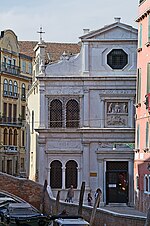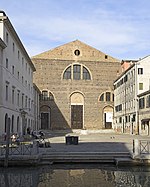Hellenic Institute of Byzantine and Post-Byzantine Studies in Venice

The Hellenic Institute of Byzantine and Post-Byzantine Studies in Venice (Italian: Istituto Ellenico di Studi Bizantini e Postbizantini di Venezia, Greek: Ελληνικό Ινστιτούτο Βυζαντινών και Μεταβυζαντινών Σπουδών στη Βενετία) is a research centre owned and funded by the Greek state in Venice, Italy, focusing on Byzantine and Post-Byzantine/Modern Greek studies. It is the only Greek research institute abroad. The institute was founded in 1951, and operates under the auspices of the Greek Ministry of Foreign Affairs, with its educational activity coordinated by the Greek Ministry of Education. The Institute owns several buildings associated with the formerly vibrant Greek community of Venice, most notably the church of San Giorgio dei Greci and the Flanginian School. It also operates its own museum and archive, which house a collection of 300 icons and numerous manuscripts, most notably a copy of the Romance of Alexander the Great.
Excerpt from the Wikipedia article Hellenic Institute of Byzantine and Post-Byzantine Studies in Venice (License: CC BY-SA 3.0, Authors, Images).Hellenic Institute of Byzantine and Post-Byzantine Studies in Venice
Calle de la Madonna, Venice Venezia-Murano-Burano
Geographical coordinates (GPS) Address Nearby Places Show on map
Geographical coordinates (GPS)
| Latitude | Longitude |
|---|---|
| N 45.4357 ° | E 12.3446 ° |
Address
Calle de la Madonna
Calle de la Madonna
30122 Venice, Venezia-Murano-Burano
Veneto, Italy
Open on Google Maps











